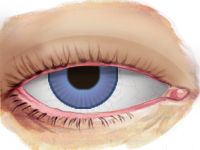| |
Dermatochalasis
As a person gets older, the connective tissue in his or her muscles and skin loses elasticity, resulting wrinkles and flaps of hanging skin. Dermatochalasis (der-mă-toh-kă-lay-sis) is an excess of the eyelid skin, which may cause drooping, sagging, and bulging of the upper lids.
 It occurs as a result of aging and is therefore mostly seen in middle-aged and elderly people, though certain inherited conditions, skin disorders, eye injuries, as well as kidney diseases can also bring about dermatochalasis at the earlier age. In some cases, severe stress or trauma can accelerate the aging process, resulting in dermatochalasis development in younger patients. It occurs as a result of aging and is therefore mostly seen in middle-aged and elderly people, though certain inherited conditions, skin disorders, eye injuries, as well as kidney diseases can also bring about dermatochalasis at the earlier age. In some cases, severe stress or trauma can accelerate the aging process, resulting in dermatochalasis development in younger patients.
In most cases, loose skin around the eyes does not affect eye functioning, though some individuals may suffer from significant vision obstruction and dermatitis, and require surgical procedures to remove excess skin, tighten connective tissue, and relieve irritation.
A mild to moderate amount of excess eyelid skin results in a tired and sad appearance. Protruding skin can be so large at times that some people may have trouble seeing. An advanced amount of excess eyelid skin can block parts of a patient's peripheral vision, especially at the top and sides.
When the upper eyelids skin sags, not only may it severely obstruct the vision, but also it can come into direct contact with the eyes, potentially leading to infection. Skin that falls onto the eyelashes makes it difficult to keep the eyes open, requiring the individual to constantly raise his or her brow to see. In addition, delicate eyelid skin itself gets prone to inflammation, irritation, and swelling.
When an individual experiences health problems related to dermatochalasis, he or she may need to have loose skin surgically tightened and or completely removed. The most common cosmetic surgery procedure for reducing the appearance of sagging eyelids is upper eyelid blepharoplasty, commonly known as eye lift. It's the primary permanent treatment of dermatochalasis and it restores the skin to its natural position by eliminating the eyelid droop. The surgery may be performed for cosmetic reasons, to improve a patient's appearance, or for functional reasons, to improve a patient's peripheral vision.
During the procedure a surgeon makes a small incision just above the upper eyelid and removes excess fat, skin, and loose muscle tissue. The eyelid is stitched back together and given an average of two to four weeks to heal. Most patients who undergo blepharoplasty are relieved of their functional and cosmetic eye problems within about a month of their surgeries. In rare cases, improved hygiene or topical steroid ointments may help as well.
An individual who believes he or she has dermatochalasis should consult an ophthalmologist, who can check for more serious problems and determine the best option for improving the look and function of the patient's eyes. |
|